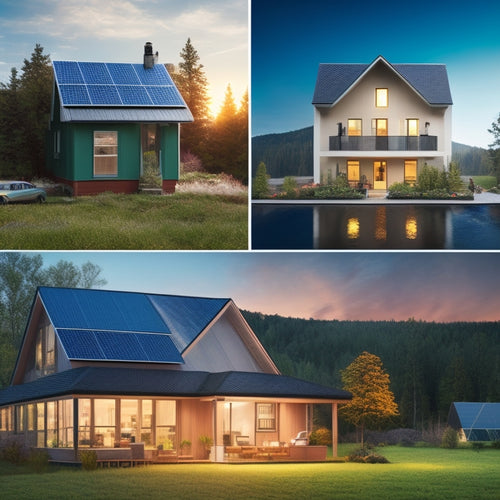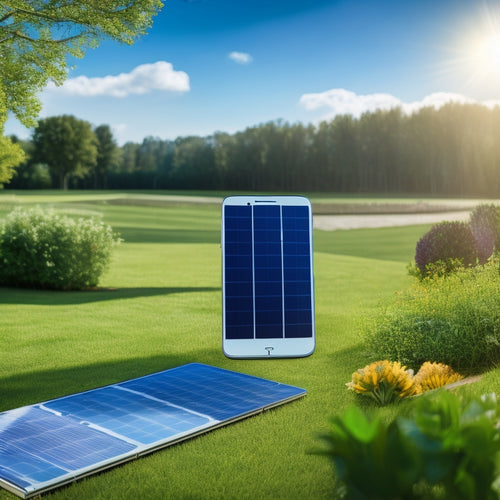
Why Install Energy-Saving Outlets in Your Home?
Share
By installing energy-saving outlets in your home, you can greatly reduce standby power consumption, lower your energy bills, and minimize your carbon footprint. These outlets eliminate idle device energy consumption, detect phantom power drains, and support integration with renewable energy sources like solar power. They also offer sleek designs that integrate seamlessly into your home aesthetics. By making the switch, you'll not only be doing your part for the environment, but you'll also be saving money on your utility bills. And once you've got them installed, you'll be curious to investigate the many other ways they can optimize your energy usage - and that's just the beginning.
Key Takeaways
- Energy-saving outlets reduce standby power consumption, minimizing energy waste and lowering energy bills.
- They eliminate idle device energy consumption, detecting and addressing phantom power drains from plugged-in devices.
- By integrating with renewable energy sources like solar power, energy-saving outlets support a more sustainable future.
- These outlets provide real-time energy usage data, enabling informed decisions on energy consumption and significant reductions in utility costs.
- By reducing unnecessary energy drain, energy-saving outlets help mitigate climate change and conserve natural resources.
Benefits of Energy-Saving Outlets
You're likely no stranger to the frustration of standby power consumption, where your devices and appliances continue to draw energy even when turned off but still plugged in.
Energy-saving outlets offer a solution to this problem, providing you with more control over your energy usage. These outlets often feature sleek and modern designs, blending seamlessly into your home's outlet aesthetics without sacrificing user convenience.
With the ability to eliminate standby power consumption, you'll enjoy greater freedom over your energy bills and a reduced carbon footprint.
Additionally, integrating renewable energy sources solar-powered fast charging into your home's energy infrastructure can further minimize your environmental impact.
How They Reduce Energy Waste
When you plug devices into energy-saving outlets, you'll notice a significant reduction in energy waste.
These outlets eliminate idle device energy consumption by detecting when a device isn't in use, and they can also identify phantom power drains, which occur when devices continue to draw power even when turned off.
By integrating solar energy, like those used in solar-powered EV charging, you can further reduce your reliance on non-renewable energy sources and minimize your carbon footprint.
Regular maintenance, including cleaning, is essential for peak energy efficiency.
Idle Device Elimination
By the time you've accumulated a handful of gadgets and devices, it's likely that some of them are perpetually plugged in, even when not in use. This leads to unnecessary energy consumption, which not only increases your energy bills but also contributes to environmental waste. Energy-saving outlets help eliminate idle devices by cutting power to them when they're not in use. This feature promotes device awareness, allowing you to identify and eliminate energy-wasting devices.
| Device | Idle Power Consumption | Annual Energy Waste |
|---|---|---|
| TV | 3-5W | 25-40 kWh |
| Computer | 2-5W | 16-40 kWh |
| Phone Charger | 0.5-2W | 4-16 kWh |
Phantom Power Detection
Across the array of devices connected to your outlets, there's a good chance that some are still drawing power even when turned off but still plugged in, a phenomenon known as standby power or vampire power.
Energy vampires, such as TVs and computers, continue to consume power even when turned off, adding to your overall power consumption.
In fact, solar-powered stations can help reduce energy waste by utilizing renewable energy sources.
By integrating energy-efficient solutions, homeowners can greatly decrease their carbon footprint.
Energy-saving outlets with phantom power detection can identify and eliminate this unnecessary energy drain.
These outlets can detect when a device is in standby mode and cut power to it, reducing energy waste and saving you money on your electricity bill.
Automatic Shut-Off Feature
You've likely wondered how energy-saving outlets can actually eliminate energy waste. The answer lies in their automatic shut-off feature. This power management capability detects when a device is in standby mode or turned off, and automatically cuts power to the outlet. This eliminates standby power consumption, also known as "vampire power," which can account for up to 10% of your energy bill.
In addition, implementing time-of-use rate strategies like those examined in EV charging stations can further reduce energy waste and lower utility bills. By optimizing energy usage during off-peak hours, you can maximize energy savings.
With energy-saving outlets, you can rest assured that your devices aren't wasting energy when not in use. This feature is especially useful for devices like TVs, computers, and chargers that continue to draw power even when turned off.
Smart Outlet Installation Process
You'll need to prepare your outlets by ensuring they're compatible with your smart outlet devices and checking for any necessary electrical upgrades, similar to how electrical infrastructure upgrades are essential for EV adoption and preventing outages Electrical Infrastructure Upgrades.
Next, you'll want to verify that your smart outlet is compatible with your devices, including smartphones, tablets, and computers.
Outlet Preparation Steps
During the initial stages of smart outlet installation, it's essential to prepare your outlets to guarantee a seamless and successful process.
You'll need to identify the outlet types in your home, including standard, tamper-resistant, and GFCI outlets. Verify you have the necessary installation tools, such as a voltage tester, wire strippers, and a screwdriver.
Turn off the power to the outlets at the circuit breaker or fuse box to prevent electrical shock. Remove the faceplates and outlet covers to access the wires.
Take note of the wire configurations and connections to facilitate a smooth installation. Proper outlet preparation will save you time and frustration in the long run, allowing you to enjoy the benefits of energy-saving outlets.
Device Compatibility Check
Before installing your energy-saving outlets, conduct a device compatibility check to guarantee seamless integration with your existing devices and appliances.
You'll want to confirm that your new outlets can handle the power requirements of your devices. Check the outlet specifications to determine the maximum power rating, voltage, and frequency.
Then, verify that your devices are compatible with these specifications. Make a list of the devices you plan to plug in, including their power consumption and voltage requirements.
Compare this list to the outlet specifications to confirm device compatibility. This check will save you from potential issues like overheating, electrical shock, or even fires.
Installation Best Practices
With your device compatibility check complete, it's time to move on to the smart outlet installation process.
You'll want to start by identifying the ideal outlet placement for your energy-saving outlets. Consider the devices you'll be plugging in and the frequency of use to determine the most convenient and efficient locations.
Safety considerations are also essential, so make certain you're installing outlets at a safe distance from water sources, such as sinks or bathtubs, and avoid areas with high humidity.
Additionally, turn off the power to the outlet at the circuit breaker before beginning installation to prevent electrical shock.
Choosing the Right Outlet Type
When it comes to energy-saving outlets, selecting the right type is vital to maximize their benefits.
You'll want to take into account the various outlet styles available, including smart outlets, timer outlets, and occupancy-sensing outlets. Each type has its own unique features and advantages, so it's important to choose the one that best fits your needs.
Look for outlets with high energy ratings, such as Energy Star or UL certification, to guarantee they meet energy efficiency standards.
Additionally, take into account outlets with advanced features like Wi-Fi connectivity, voice control, or USB charging ports.
Energy Monitoring and Tracking
One of the most significant advantages of energy-saving outlets is their ability to monitor and track your energy consumption.
This feature allows you to gain useful perspectives into your usage patterns, identifying areas where you can make adjustments to reduce your energy consumption.
- You can pinpoint which devices are consuming the most energy
- Track your energy usage in real-time
- Receive notifications when devices are turned on or off
- Identify opportunities to optimize your energy usage
- Make data-driven decisions to reduce your carbon footprint
Saving Money on Utility Bills
Your energy-saving outlets can help you slash your utility bills by providing useful revelations into your energy consumption patterns.
With real-time data on your energy usage, you can identify areas where you can cut back and optimize your energy efficiency.
By plugging your devices into these smart outlets, you'll gain understanding into which appliances are guzzling the most energy, allowing you to make informed decisions about how to reduce your utility cost.
This newfound awareness will enable you to make changes that lead to significant utility cost reduction, ultimately saving you money and increasing your energy efficiency.
Environmental Impact of Smart Outlets
Every day, millions of devices are plugged into outlets, consuming massive amounts of energy and contributing to environmental degradation.
By installing energy-saving outlets, you're taking a significant step towards reducing your carbon footprint. These outlets utilize sustainable technology to minimize energy waste, promoting energy conservation and a healthier planet.
Here are some key benefits:
- Slash greenhouse gas emissions and mitigate climate change
- Reduce air and water pollution from fossil fuels
- Conserve natural resources and decrease landfill waste
- Help protect endangered species and preserve ecosystems
- Enjoy a clear conscience, knowing you're contributing to a sustainable future
Integrating With Smart Home Systems
Configuring your energy-saving outlets to integrate with your smart home system allows for seamless automation and optimization of your energy usage, further amplifying their eco-friendly benefits.
You'll be able to control and monitor your outlets remotely, receiving real-time updates on energy consumption and receiving notifications when devices are left on.
When choosing energy-saving outlets for smart home integration, consider compatibility with your existing system. Confirm the outlets are compatible with your smart home hub or bridge, and check if they support popular smart home protocols like Zigbee or Z-Wave.
Frequently Asked Questions
Can I Install Energy-Saving Outlets Myself or Do I Need a Professional?
You can install energy-saving outlets yourself, but make certain you follow safety precautions and installation guidelines to avoid electrical shocks or fires; if unsure, consider hiring a professional to guarantee a safe and correct installation.
Are Energy-Saving Outlets Compatible With All Types of Light Bulbs?
You'll find that energy-saving outlets are compatible with most bulb types, ensuring seamless integration and maximum energy efficiency, but it's crucial to check the outlet's specifications to guarantee compatibility with your preferred bulb, freeing you to make an informed decision.
Do Energy-Saving Outlets Affect the Performance of My Devices?
It's a coincidence you're wondering this: do energy-saving outlets affect device performance? Rest assured, they won't throttle your devices' speed. In fact, they enhance device efficiency, amplifying energy savings while ensuring seamless device operation.
Can I Control Energy-Saving Outlets Remotely Using My Smartphone?
You can control energy-saving outlets remotely using your smartphone, thanks to smart home integration, which enables energy monitoring and scheduling, allowing you to turn devices on/off and track energy usage from anywhere, at any time.
Are Energy-Saving Outlets More Expensive Than Traditional Outlets?
Are you willing to sacrifice long-term savings for a few extra bucks upfront? Energy-saving outlets may cost more initially, but they'll pay for themselves through reduced energy consumption, making them a smart investment in your freedom from wasteful spending.
Related Posts
-

10 Best WiFi Outlets for Tracking Home Energy Usage
You can optimize your home's energy usage with the right WiFi outlets, which provide real-time monitoring and control...
-

What Does Your Home Energy Audit Report Reveal?
Your home energy audit report reveals a detailed analysis of your energy consumption patterns, highlighting areas of ...
-

7 Best Solar Panel Upkeep Apps for Homeowners
You can optimize your solar panel's energy output and efficiency by up to 20% with regular maintenance, which is wher...


